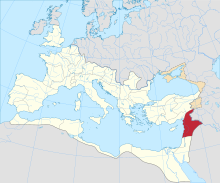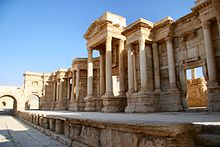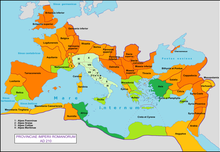Roman Syria
You can helpexpand this article with text translated fromthe corresponding articlein Italian.(February 2024)Click [show] for important translation instructions.
|
| Provincia Syria ἐπαρχία Συρίας eparchía Syrías | |||||||||||||||
|---|---|---|---|---|---|---|---|---|---|---|---|---|---|---|---|
| Province of theRoman Empire | |||||||||||||||
| 64 BC–198 AD | |||||||||||||||
 Roman Syria highlighted in 125 AD | |||||||||||||||
| Capital | Antioch (modern-dayAntakya,Hatay,Turkey) | ||||||||||||||
| History | |||||||||||||||
• Conquest ofCoele-SyriabyPompey | 64 BC | ||||||||||||||
• Province divided intoCoele SyriaandPhoenice | 198 AD | ||||||||||||||
| |||||||||||||||
| Today part of | |||||||||||||||
Roman Syriawas an earlyRoman provinceannexed to theRoman Republicin 64 BC byPompeyin theThird Mithridatic Warfollowing the defeat ofKing of ArmeniaTigranes the Great,who had become the protector of the Hellenistic kingdom ofSyria.[1]
Following the partition of theHerodian Kingdom of Judeainto atetrarchyin 4 BC, it was gradually absorbed into Roman provinces, with Roman Syria anne xingIturea and Trachonitis.By the late 2nd century AD, the province was divided intoCoele SyriaandSyria Phoenice.
Provincia Syria
[edit]

Syria wasannexedto theRoman Republicin 64 BC, whenPompey the Greathad theSeleucid kingAntiochus XIII Asiaticusexecuted and deposed his successorPhilip II Philoromaeus.Pompey appointedMarcus Aemilius Scaurusto the post of governor of Syria.
Following thefall of the Roman Republicand its transformation into theRoman Empire,Syria became a Roman imperial province, governed by aLegate.During the early empire, the Roman army in Syria accounted for three legions with auxiliaries who defended the border withParthia.
In 6 AD, EmperorAugustusdeposed theethnarchHerod Archelausand unitedJudea,SamariaandIdumeainto theRoman province of Judea;such province was placed under the direct authority of the Legate of SyriaPublius Sulpicius Quirinius,who appointedCoponiusasPrefectof Judea. Following the death ofHerod Philip II(34 AD) and the removal ofHerod Antipas(39 AD)Ituraea,Trachonitis,GalileeandPereawere also transferred under the jurisdiction of the province of Syria.
From 37 to 41 AD, much of the southern region was separated from Syria and transformed into aclient kingdomunderHerod Agrippa I.After Agrippa's death, his kingdom was gradually re-absorbed into the Roman Empire, until it was officially transformed into a Roman province following the death ofHerod Agrippa II.
Syrian province forces were directly engaged in theFirst Jewish–Roman Warof 66–70 AD. In 66 AD,Cestius Gallus,legate of Syria, brought the Syrian army, based onLegio XII Fulminata,reinforced by auxiliary troops, to restore order in Judaea and quell the revolt. The legion, however, was ambushed and destroyed by Jewish rebels at theBattle of Beth Horon,a result that shocked the Roman leadership. The future emperorVespasianwas then put in charge of subduing the Jewish revolt. In the summer of 69, Vespasian, with the Syrian units supporting him, launched his bid to become Roman emperor. He defeated his rivalVitelliusand ruled as emperor for ten years when he was succeeded by his sonTitus.
Based on an inscription recovered fromDorin 1948,Gargilius Antiquuswas known to have been the governor of a province in the eastern part of the Empire, possibly Syria, between his consulate and governing Asia.[2]In November 2016, an inscription in Greek was recovered off the coast of Dor byHaifa Universityunderwater archaeologists, which attests that Antiquus was governor of the province ofJudeabetween 120 and 130, possibly prior to theBar Kokhba revolt.[3]
As related byTheodor Mommsen,
The governor of Syria retained the civil administration of the whole large province undiminished, and held for long alone in all Asia a command of the first rank. [...] It was only in the course of the second century that a diminution of his prerogatives occurred, whenHadriantookone of the four legionsfrom the governor of Syria and handed it over to the governor ofPalestine.[4]
Aftermath
[edit]Division into Coele Syria and Syria Phoenice
[edit]| Provincia Coele Syria ἐπαρχία Κοίλης Συρίας | |||||||||||
|---|---|---|---|---|---|---|---|---|---|---|---|
| Province of theRoman Empire | |||||||||||
| 198–end of 4th century | |||||||||||
 Roman Empire in 210 | |||||||||||
| Capital | Antioch | ||||||||||
| History | |||||||||||
• Established | 198 | ||||||||||
• Disestablished | end of 4th century | ||||||||||
| |||||||||||
| Today part of | |||||||||||
| Provincia Syria Phoenice | |||||||||||||
|---|---|---|---|---|---|---|---|---|---|---|---|---|---|
| Province of theRoman Empire | |||||||||||||
| 198–end of 4th century | |||||||||||||
 Roman Empire in 210 | |||||||||||||
| Capital | Tyre | ||||||||||||
| History | |||||||||||||
• Established | 198 | ||||||||||||
• Disestablished | end of 4th century | ||||||||||||
| |||||||||||||
Septimius Severusdivided the province of Syria proper intoSyria CoeleandSyria Phoenice,[5][6]with Antioch andTyreas their respective provincial capitals.
As related byTheodor Mommsen,
It wasSeveruswho at length withdrew the first place in the Roman military hierarchy from the Syrian governor. After having subdued the province—which had wished at that time to makeNigeremperor, as it had formerly done with its governorVespasian—amidst resistance from the capital Antioch in particular, he ordained its partition into a northern and a southern half, and gave to the governor of the former, which was calledCoele-Syria,two legions, to the governor of the latter, the province ofSyro-Phoenicia,one [legion].[4]
From the later 2nd century, theRoman Senateincluded several notable Syrians, includingClaudius PompeianusandAvidius Cassius.
Syria was of crucial strategic importance during theCrisis of the Third Century.In 244 AD, Rome was ruled by a native Syrian from Philippopolis (modern dayShahba) in the province of Arabia Petraea. The emperor was Marcus Iulius Philippus, more commonly known asPhilip the Arab.Philip became the 33rd emperor of Rome upon its millennial celebration.
Roman Syria was invaded in 252/253 (the date is disputed) after a Roman field army was destroyed in theBattle of Barbalissosby the King of PersiaShapur Iwhich left the Euphrates river unguarded and the region was pillaged by the Persians. In 259/260 a similar event happened whenShapur Iagain defeated a Roman field army and captured the Roman emperor, Valerian, alive at theBattle of Edessa.Again, Roman Syria suffered as cities were captured, sacked and pillaged.
From 268 to 273, Syria was part of the breakawayPalmyrene Empire.
| The 'Orient' in the time ofSeptimius Severusc. 200 AD[7] | ||
|---|---|---|
| Coele Syria | Provincia Syria Coele | |
| Phoenicia | Provincia Syria Phoenice | |
| Palaestina | Provincia Syria Palaestina | |
| Arabia | Provincia Arabia Petraea | |
Dominate reform
[edit]Following the reforms ofDiocletian,Syria Coele became part of theDiocese of the East.[8]Sometime between 330 and 350 (likely c. 341), the province ofEuphratensiswas created out of the territory ofSyria Coelealong the western bank of theEuphratesand the formerKingdom of Commagene,withHierapolisas its capital.[9]
Syria in the Byzantine Empire
[edit]
After c. 415,Syria Coelewas further subdivided intoSyria I(orSyria Prima), with its capital remaining atAntioch,andSyria II(Syria Secunda) orSyria Salutaris,with its capital atApamea on the Orontes.In 528,Justinian Icarved out the small coastal provinceTheodoriasout of territory from both provinces.[8]

The region remained one of the most important provinces of theByzantine Empire.It wasoccupiedby theSasaniansbetween 609 and 628, then reconquered by the emperorHeraclius,but lost again to theadvancing Muslimsafter theBattle of Yarmoukand thefall of Antioch.[8][10][11] The city ofAntiochwas reconquered byNikephorus Phocasin 963, along with other parts of the country, at that time under theHamdanids,although still under the official suzerainty of theAbbasidcaliphs and also claimed by theFatimidcaliphs. After emperorJohn Kurkuasfailed to conquer Syria up to Jerusalem, a Muslim reconquest of Syria followed in the late 970s undertaken by the Fatimid Caliphate that resulted in the ousting of the Byzantines from most parts of Syria. However, Antioch and other northern parts of Syria remained in the empire and other parts were under the protection of theemperorsthrough their Hamdanid,Mirdasid,andMarwanidproxies, until theSeljukarrival, who after three decades of incursions, conquered Antioch in 1084. Antioch was captured again during the 12th century by the revived armies of theComnenii.However, by that time the city was regarded as part of Asia Minor and not of Syria.
Demographics
[edit]Provinicia Syria had a diverse demographic distribution. The rural inland was mostly populated byAramaicspeakers descended from variousWest Semiticpeoples who inhabited Syria.Arabswere settled throughoutHauran,TrachonitisandEmesawhich they controlled. Arabs were also part ofPalmyra's composition, which included Aramaeans, Arabs andAmorites.[12]ThePhoeniciancoast maintained aPhoenician-speaking majority well into the end of 2nd century, and their main urban centers includedTyre,SidonandBerytus.
On the other hand,Greekscomprised a majority in Hellenistic urban centers suchAntioch,Apamea,Cyrrhusand theDecapolis,which had been settled by Greeks underSeleucidpatronage.[13]
Estimates for the population of the entireLevantin the 1st century vary from 3.5–4 million to 6 million, levels only matched even by 19th century levels. Urban centers peaked and so did population density in the rural settlements.AntiochandPalmyrareached a peak of 200,000–250,000 inhabitants, while Apamea counted 117,000 'free citizens' circa AD 6. Combined with their dependancies and villages, Apamea and Cyrrhus may have counted as high as 500,000 each. TheSyrian Coastal Mountain Range,marginal hill country, were less densely settled and had a population of around 40–50,000.[14]
Identity
[edit]The inhabitants of Syria adoptedGreek customswhile maintaining elements ofNear Easternculture. The continuity of pre-Hellenistic cultures was inconsistent across different regions, and where it existed, it varied, includingAramean,Phoenician,andneo-Hittiteinfluences. However, many areas documented exclusively Greek elements.[15]
In contrast toJews,who shared collective historical memories, Syrians lacked a unified cultural or social identity. The unifying aspects in Roman Syria were Greek civic structures and narratives promoted by Roman imperial rule, suggesting that Syrian culture was largely defined through Greek and Roman influences. The term 'Syrian' therefore primarily functioned as a geographical designation.[15]
Episcopal sees
[edit]Ancient episcopal sees of the lateRoman provinceofSyria Prima (I)listed in theAnnuario Pontificioastitular sees:[16]
- Anasartha(Khanasir)
- Barcusus(Baquza orBanqusa)
- Beroea(Aleppo)
- Chalcis in Syria(Qinnasrin)
- Gabala(Jableh)
- Gabula(at the marsh of Al-Jabbul)
- Gindarus(Jandairis)
- Laodicea in Syria(Latakia)
- Salamias(Salamiyah)
- Seleucia Pieria
Ancient episcopal sees of the late Roman province ofSyria Secunda (II)listed in theAnnuario Pontificioastitular sees:[16]
- Apamea in Syria,the Metropolitan Archdiocese
- Arethusa(Al-Rastan)
- Balanea(Baniyas)
- Epiphania in Syria(Hama)
- Larissa in Syria(Shaizar)
- Mariamme(Maryamin)
- Raphanea
- Seleucobelus(Seleucopolis)
See also
[edit]References
[edit]- ^Sicker, Martin(2001).Between Rome and Jerusalem: 300 Years of Roman-Judaean Relations.Greenwood Publishing Group. p. 39.ISBN978-0-275-97140-3.
- ^Dov Gera and Hannah M. Cotton,"A Dedication from Dor to a Governor of Syria",Israel Exploration Journal,41 (1991), pp. 258–66
- ^Divers Find Unexpected Roman Inscription From the Eve of Bar-Kochba RevoltHaaretz (Last accessed 6 June 2017)
- ^abMommsen 1886,pp. 117–118.
- ^Marquardt 1892,p. 373: "Tandis que la Judée ou Syria Palaestina demeurait ainsi séparée de la Syrie depuis l'an 66 après J.-C., la Syrie elle-même fut plus tard divisée en deux provinces: la Syria magna ou Syria Coele, et la Syria Phoenice".
- ^Adkins & Adkins 1998,p. 121: "Septimius Severus divided the remaining province into Syria Coele and Syria Phoenice".
- ^Cohen, Getzel M. (3 October 2006).The Hellenistic Settlements in Syria, the Red Sea Basin, and North Africa.University of California Press. p. 40, note 63.ISBN978-0-520-93102-2.
In 194 A.D. The emperor Septimus Severus divided the province of Syria and made the northern part into a separate province called Coele Syria.
- ^abcKazhdan, Alexander, ed. (1991).Oxford Dictionary of Byzantium.Oxford University Press. p. 1999.ISBN978-0-19-504652-6.
- ^Kazhdan, Alexander, ed. (1991).Oxford Dictionary of Byzantium.Oxford University Press. p. 748.ISBN978-0-19-504652-6.
- ^Howard-Johnson, James D.(2006).East Rome, Sasanian Persia and the End of Antiquity.Ashgate Publishing, Ltd. p. 6.ISBN978-0-86078-992-5.
- ^Antony, Sean (2006).Muhammad and the Empires of Faith: The Making of the Prophet of Islam.University of California Press. p. 184.ISBN978-0-520-34041-1.
- ^Stoneman, Richard (1994) [1992].Palmyra and Its Empire: Zenobia's Revolt Against Rome.University of Michigan Press.ISBN978-0-472-08315-2.
- ^Cohen, Getzel M. (2006).The Hellenistic Settlements in Syria, the Red Sea Basin, and North Africa.University of California Press.ISBN9780520931022.
- ^Kennedy, David L."Demography, the Population of Syria and the Census of Q. Aemilius Secundus".Academia.
- ^abAndrade, Nathanael J., ed. (2013),"Introduction",Syrian Identity in the Greco-Roman World,Greek Culture in the Roman World, Cambridge: Cambridge University Press, pp. 10–11,doi:10.1017/cbo9780511997808.003,ISBN978-0-511-99780-8,retrieved2024-02-04
- ^abAnnuario Pontificio 2013(Libreria Editrice Vaticana 2013ISBN978-88-209-9070-1), "Sedi titolari", pp. 819-1013
Sources
[edit]- Adkins, Lesley; Adkins, Roy A. (1998).Handbook to Life in Ancient Rome.ISBN978-0-19-512332-6.
- Marquardt, Joachim (1892).L'organisation de l'Empire romain.
- Mommsen, Theodor(1886).The History of Rome.R. Bentley.
External links
[edit]- Bagnall, R., J. Drinkwater, A. Esmonde-Cleary, W. Harris, R. Knapp, S. Mitchell, S. Parker, C. Wells, J. Wilkes, R. Talbert, M. E. Downs, M. Joann McDaniel, B. Z. Lund, T. Elliott, S. Gillies (30 January 2018)."Places: 981550 (Syria)".Pleiades.RetrievedMarch 8,2012.
{{cite web}}:CS1 maint: multiple names: authors list (link)
- States and territories established in the 1st century BC
- States and territories established in the 190s
- Roman Syria
- Ancient Levant
- Seleucid Empire successor states
- Former countries in West Asia
- 60s BC establishments
- 1st-century BC establishments in the Roman Republic
- States and territories disestablished in the 2nd century
- 198 disestablishments
- 190s disestablishments in the Roman Empire
- 1st-century BC establishments
- 2nd-century disestablishments
- Jews and Judaism in the Roman Empire




